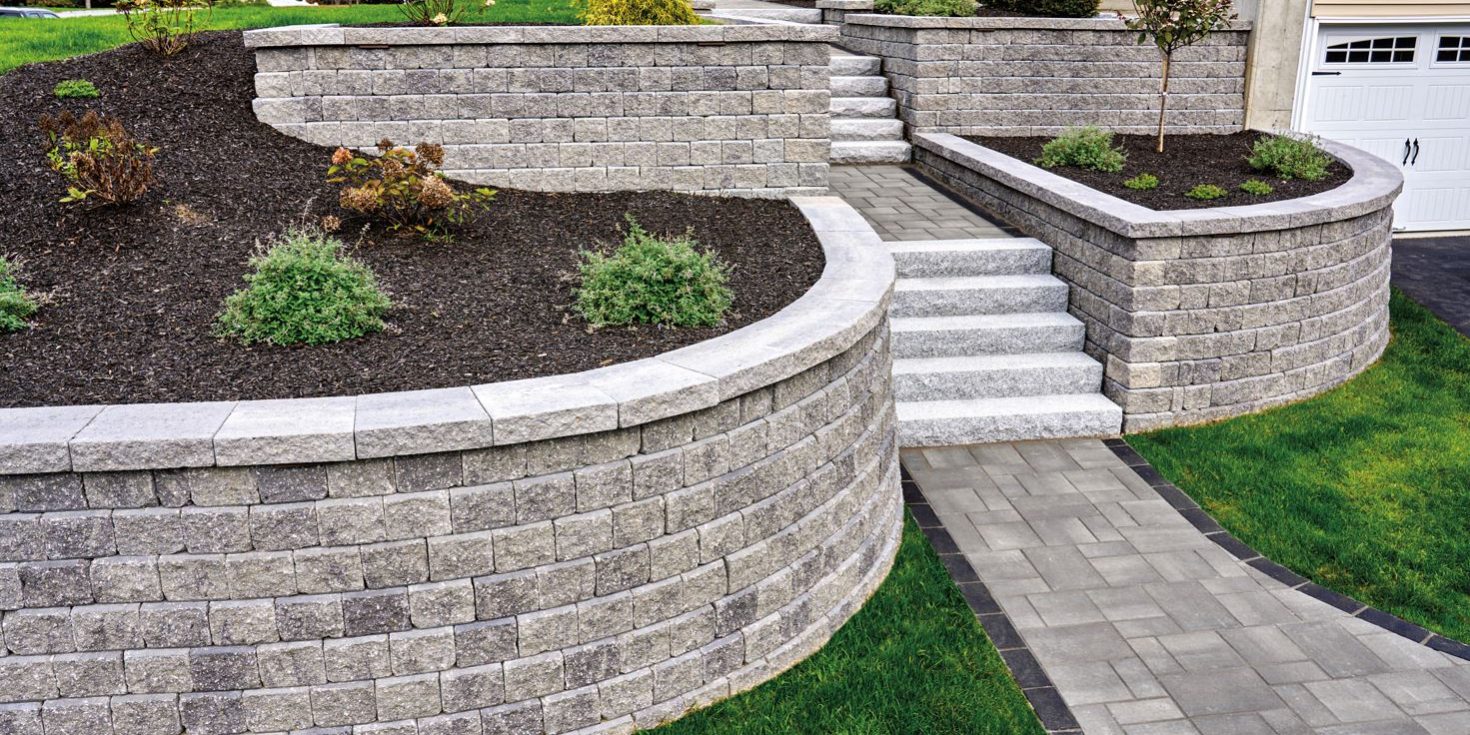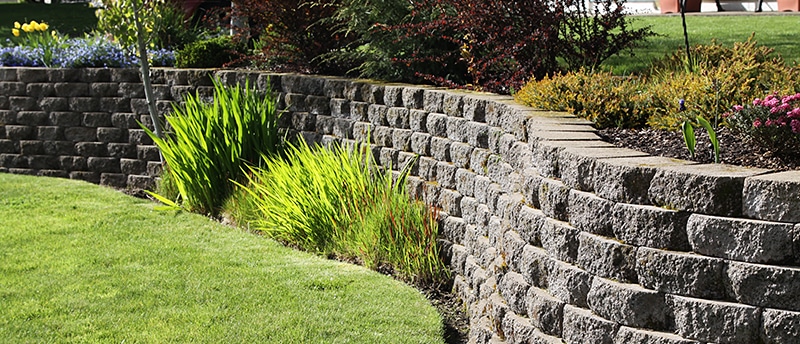Here’s why OKC Precision Retaining Walls are vital for safeguarding sloped properties
Here’s why OKC Precision Retaining Walls are vital for safeguarding sloped properties
Blog Article
The Essential Overview to Understanding the Performance of Retaining Walls
When it involves handling sloped landscapes, retaining walls are crucial. They not only hold back soil however additionally avoid disintegration and shield your residential property from possible landslides. Comprehending their functionality can assist you make educated choices about style and upkeep. Yet what kinds of retaining walls are available, and how do you select the ideal materials? Let's check out these essential factors to consider even more.
What Are Retaining Walls and Their Function?
Retaining walls are crucial frameworks developed to hold back dirt and avoid erosion, specifically on sloped landscapes. They supply stability to your residential property, making sure that soil continues to be in position and avoiding prospective landslides. When you consider a keeping wall surface, consider its duty in handling water drainage, which can deteriorate dirt with time. Without these walls, you could deal with expensive damage to your landscape and structure.
Additionally, retaining walls can develop useful spaces in your backyard. By leveling out a sloped area, you can acquire extra practical outside space for horticulture, patios, or play areas. The style and products you choose can boost your residential or commercial property's looks, making it aesthetically appealing.
Ultimately, recognizing the purpose of retaining walls helps you appreciate their value in landscape management (OKC Precision Retaining Walls). They not just shield your home yet likewise add to the overall charm and functionality of your outdoor space
Kinds Of Retaining Walls: An Introduction
When it involves managing dirt and water drainage in your landscape, knowing the different sorts of retaining walls can assist you make an enlightened selection for your home. Gravity walls rely on their weight to hold back soil, making them a tough alternative for smaller slopes. Cantilever walls, on the other hand, use a lever-like layout, which allows them to sustain more significant loads with less product. For even more complicated terrains, secured walls offer added stability by making use of cables anchored right into the ground. There are modular block walls, which provide adaptability and convenience of installation with interlocking blocks. Each type has its benefits and applications, so take into consideration aspects like dirt problems, height needs, and visual preferences prior to making your decision. Recognizing these alternatives will certainly equip you to boost your landscape efficiently while preventing erosion and handling water drainage.
Key Materials Utilized in Retaining Wall Surface Building
To create a durable and reliable retaining wall, selecting the best materials is crucial. Precast concrete blocks offer adaptability in layout, while poured concrete supplies a seamless look.
Timber is an additional choice, especially for smaller sized walls, however bear in mind it might not last as long as a result of degeneration. Steel and gabion walls, which utilize cord mesh loaded with rocks, are also effective for details scenarios. Each material has its own benefits and downsides, so consider your wall surface's purpose, place, and budget plan. Inevitably, the ideal product will certainly improve the wall's security and durability, ensuring it satisfies your requirements while standing the examination of time.

Layout Considerations for Efficient Retaining Walls
Creating a reliable retaining wall surface involves mindful factor to consider of several essential elements, as the wall surface needs to stand up to both upright and lateral pressures. First, assess the dirt type and its buildings; natural dirts behave differently than granular ones. You'll likewise want to establish the elevation of the wall, as taller walls require more robust layout remedies.
Next, think about water drainage. Proper drain stops water accumulation behind the wall, decreasing pressure and possible failing. Include weep openings or water drainage pipes for effective water administration.
Also, think of the products you'll make use of. Various products, like concrete, rock, or hardwood, offer varying staminas and looks.
Ultimately, do not ignore neighborhood policies and codes. They usually dictate layout requirements and construction methods. By resolving these considerations, you can guarantee your retaining wall is not just practical but additionally resilient and secure.
Applications of Retaining Walls in Landscaping and Construction
Retaining walls offer a necessary role in both landscape design and construction, as they aid manage adjustments in elevation and stop dirt disintegration. In landscape design, you can use them to produce beautiful terraced gardens, permitting you to maximize your outside room while including visual passion. They also assist define areas, such as paths or flower beds, improving your landscape's total design.
In building, retaining walls give security to structures built on sloped land, assuring safety and toughness. They're frequently used in roads and business residential or commercial properties to manage planet activity and drainage effectively. By protecting against soil from changing, retaining walls protect foundations and preserve the integrity of your building jobs.
Whether you're wanting to improve visual appeal or guarantee structural stability, retaining walls supply useful remedies that can greatly profit your landscape and building ventures. Accept their convenience to attain both aesthetic and practical objectives.
Maintenance Tips for Long-Lasting Retaining Walls
To keep your retaining walls in terrific form, routine examinations and prompt repair services are necessary. You also need to guarantee correct water drainage remedies to stop water buildup, which can weaken the framework. Lastly, handling greenery around the walls will help maintain their honesty and prolong their life expectancy.

Regular Maintenances
While you may believe your retaining wall surface can stand strong on its own, routine assessments and prompt repair services are essential for its durability. Look for any type of moving in the soil bordering the wall, as this can helpful site suggest much deeper problems. By being positive about assessments and repair work, you'll guarantee your retaining wall remains durable and useful for years to come.
Proper Drain Solutions
Efficient drain is essential for keeping the honesty of your retaining wall, as water accumulation can cause substantial structural problems. To guarantee correct drainage, mount weep holes at regular intervals along the wall surface. These tiny openings enable excess water to escape, preventing pressure build-up behind the wall surface. You ought to additionally consider including a water drainage pipeline at the base of the wall, directing water away from the framework. Usage gravel backfill to promote drainage and decrease soil saturation. Consistently inspect and clear any type of particles from drain systems to keep circulation. By applying these options, you'll improve the longevity and stability of your retaining wall surface, guarding it against potential damages caused by water accumulation.
Plant Life Administration Approaches
Healthy greenery can play a vital role in the long life of your retaining wall surface. To guarantee its effectiveness, you'll wish to manage the plant life around it carefully. Beginning by selecting ingrained plants that assist maintain the dirt without causing pressure on the wall surface - OKC Precision Retaining Walls. Consistently look for invasive varieties that might undermine your wall's honesty.
It's check it out essential to stay clear of overwatering, as too much dampness can wear down the wall's structure. By carrying out these plants administration methods, you'll sustain your retaining wall's resilience and improve the surrounding landscape's beauty.
Usual Problems and Solutions for Retaining Walls
When it pertains to retaining walls, soil erosion and drainage concerns can trigger significant frustrations. You require to ensure your wall is properly developed to avoid erosion and has an effective water drainage system in position. Allow's discover some typical problems and their solutions to maintain your retaining wall surface strong and useful.
Dirt Erosion Avoidance
Dirt disintegration can be a significant obstacle for retaining walls, especially if not appropriately resolved. When soil deteriorates, it can undermine the wall's security, leading to possible failings. By taking these positive steps, you can considerably improve the long life and effectiveness of your retaining wall versus soil erosion.
Drainage System Importance
A trustworthy drainage system is vital for the efficiency and long life of retaining walls. Without appropriate drainage, water can accumulate behind the wall, producing extreme pressure that could result in architectural failing. You might notice protruding or breaking, which signifies the demand for immediate focus. To prevent these problems, take into consideration mounting weep openings, which enable water to get away, or a perforated drain that reroutes water far from the wall surface. Consistently look for clogs in your drain system, as debris can hinder its performance. Keeping correct water drainage not just shields your retaining wall surface however likewise guarantees the surrounding landscape stays stable. By remaining aggressive, you can prevent expensive repair services and extend the life of your retaining wall.
Regularly Asked Inquiries
Just How Do Retaining Walls Influence Drain Solutions?
Retaining walls can considerably affect drainage systems by rerouting water flow. They avoid dirt erosion and manage groundwater degrees, ensuring security. If you're intending construction, take into consideration exactly how they'll interact with your water drainage style for perfect outcomes.
Can Retaining Walls Be Installed on Inclines?
Yes, you can mount retaining walls on slopes. They aid stabilize the dirt and avoid disintegration. Just assure proper drain and pick the best materials to manage the stress from the dirt behind the wall surface.
What Is the Life-span of a Typical Retaining Wall Surface?
A common retaining wall surface lasts around 20 to 50 years, depending on materials, upkeep, and ecological conditions. You ought to frequently examine it to assure its longevity and site web resolve any problems promptly to prevent expensive fixings.
Are Permits Required for Structure Retaining Walls?
Yes, you typically need licenses for constructing retaining walls. Inspect your local structure codes and regulations to ensure conformity. It's essential to secure the appropriate permissions before starting your project to avoid possible fines or issues.
Just How Do Retaining Walls Effect Home Value?
Retaining walls can favorably affect your property value by enhancing aesthetics, preventing disintegration, and producing usable exterior room. OKC Precision Retaining Walls. They additionally show great land administration, making your residential or commercial property a lot more appealing to potential customers in the market
Report this page